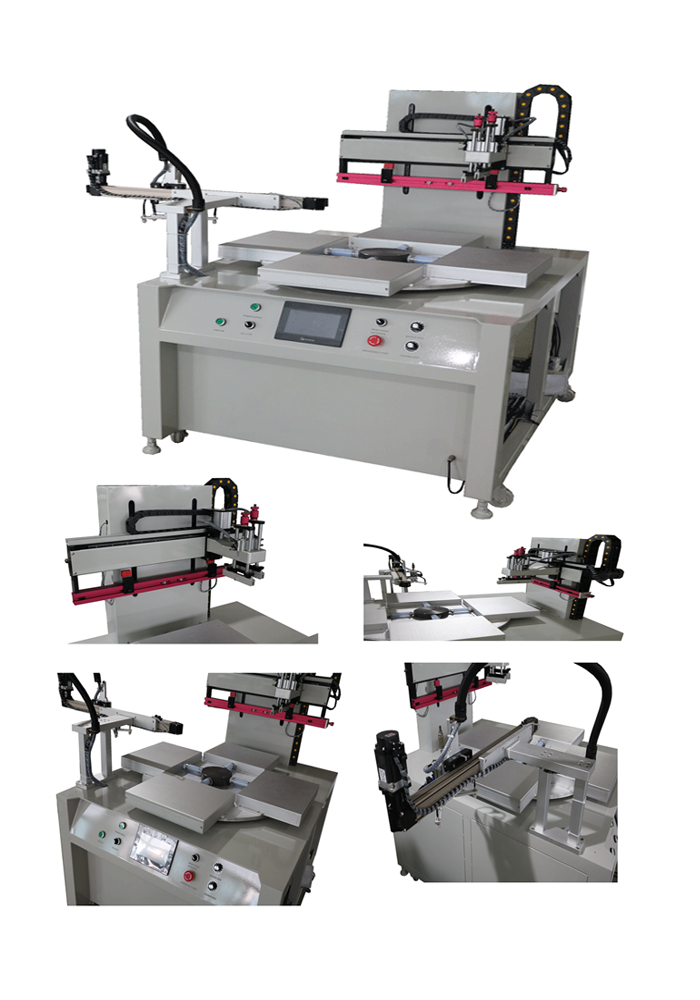News
Rotary screen printing machine sells worldwide
2018-11-08
It is a recent hotspot to upgrade a single-face flat screen printer to a faster rotary screen printer. It greatly improves the work efficiency, reduces the labor intensity of workers, improves the safety performance, and thus is favored by many users.
1) The rotary screen printing machine can be customized, with 4 to 10 work tables, and the work table is rotated in turn to enter the printing position. The work table where the operator places the product and the work table that completes the printing do not interfere with each other, which saves the preparation time for printing, thereby greatly improving the production efficiency. The rotating device of the rotary screen printing machine usually has high-precision indexing plate control, precise operation and easy printing quality.
2) Use of the robot.
The rotary screen printing machine can be installed with a robot to complete the automatic loading and unloading of the product. The first is automatic cutting. Since the rotary screen printing machine has multiple stations, the robot is installed on the upper part of the empty station where printing is completed, and the degree of automation is further improved with the use of the UV curing machine or the tunnel drying furnace. For some products with more regular shapes, the loading robot can be installed to further realize the production of the assembly line.
3) Application of servo system
The rotary screen printing machine has a fast printing speed and has obvious advantages for large-volume product printing. However, the mechanical adjustment after the replacement of the product is relatively cumbersome, which imposes strict requirements on the technical requirements of the operator. If the screen is up and down, the left and right screens and the printing stroke are controlled by servo motor, the difficulty of adjusting the machine will be reduced.
With the acceleration of social transformation and upgrading, the competition in the printing machinery industry is becoming increasingly fierce. The rising cost of domestic manufacturing and the harshness of market competition pose serious challenges to the survival of the printing machinery manufacturing industry. Only those companies that can survive the storms in the market can stand up to the forefront.
1) The rotary screen printing machine can be customized, with 4 to 10 work tables, and the work table is rotated in turn to enter the printing position. The work table where the operator places the product and the work table that completes the printing do not interfere with each other, which saves the preparation time for printing, thereby greatly improving the production efficiency. The rotating device of the rotary screen printing machine usually has high-precision indexing plate control, precise operation and easy printing quality.
2) Use of the robot.
The rotary screen printing machine can be installed with a robot to complete the automatic loading and unloading of the product. The first is automatic cutting. Since the rotary screen printing machine has multiple stations, the robot is installed on the upper part of the empty station where printing is completed, and the degree of automation is further improved with the use of the UV curing machine or the tunnel drying furnace. For some products with more regular shapes, the loading robot can be installed to further realize the production of the assembly line.
3) Application of servo system
The rotary screen printing machine has a fast printing speed and has obvious advantages for large-volume product printing. However, the mechanical adjustment after the replacement of the product is relatively cumbersome, which imposes strict requirements on the technical requirements of the operator. If the screen is up and down, the left and right screens and the printing stroke are controlled by servo motor, the difficulty of adjusting the machine will be reduced.
With the acceleration of social transformation and upgrading, the competition in the printing machinery industry is becoming increasingly fierce. The rising cost of domestic manufacturing and the harshness of market competition pose serious challenges to the survival of the printing machinery manufacturing industry. Only those companies that can survive the storms in the market can stand up to the forefront.

